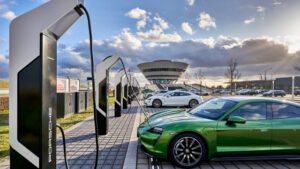
How the Transportation Industry Is Handling the EV Push
By Jack Shaw
Shifting away from fossil fuels is one way the transportation industry can reduce its greenhouse gas emissions. Electricity is the greenest alternative to fossil fuel, making electromobility, or e-mobility, synonymous with sustainability.
The push for electric vehicles (EVs) is practically as old as the global concern for climate change. Have private car owners and fleet managers reacted positively to decarbonization? Here’s how the transportation industry has handled the EV adoption drive.
China Is Taking the Lead
No country has embraced EVs more than China. In 2024, the East Asian nation’s electric car sales exceeded 11 million, accounting for the majority of the 17 million units sold worldwide. With this figure, the world’s second-largest economy retained its lead over Europe and the United States.
China is winning the race by setting the conditions for an EV ecosystem to thrive, through streamlined policies and subsidies. The Chinese government poured resources into EV development and attracted Tesla to build facilities. The American automaker spurred innovation among local Chinese brands, enabling domestic electric car, taxi, and bus producers to balance technology and affordability over time.
The current EV production and adoption leader was in this position after venturing into electromobility early. The Chinese government wanted a slice of the auto industry but knew it was decades behind established European, American, and Japanese gas-powered car makers, so it shifted gears. While the risk of failure was high, Beijing found the reward from global EV dominance more compelling.
Aside from the economic and political advantages of mastering electromobility before anybody else, EVs represent an elegant solution to China’s many problems — imported fossil fuel overreliance, severe urban air pollution, and declining exports during the 2008 financial crisis.
China never looked back. Pundits project China to stay unrivaled in lithium-ion battery production over the long term, claiming 6.268 gigawatt-hours (GWh) or almost 70% of the global capacity by 2030. The forecast expects the U.S. to rank second, with a capacity of 1.261 GWh.
Moreover, China is also in the driver’s seat regarding hydrogen fuel-cell vehicle (HFCV) production and sales. In the nine months of 2024, the country sold more commercial HFCVs domestically than the rest of the world sold hydrogen-powered cars.
The growth trend of the country’s hydrogen fuel-cell industry ended in 2024 — production plummeted by 10.4%, while sales dipped by 12.6%. However, these are only bumps in the road. China expects the adoption of hydrogen-fueled commercial vehicles to go full throttle in 2025 after removing legal barriers.
EV Maintenance Is Discouraging Car Buyers
The U.S. has done its part in incentivizing consumers to switch to EVs with the passage of the Inflation Reduction Act of 2022. The law allows eligible buyers to claim up to $7,500 in federal tax credits, although the qualifications are rather stringent.
In 2023, American consumers’ confidence in EV range and charging infrastructure rose. This reflects the progress automakers have made in battery size and density. Such approval is a testament that municipalities and property owners have done a commendable job expanding the network of Level 2 and Direct Current Fast Charging public charging stations nationwide.
Despite these remarkable developments, interest in EV ownership in the U.S. is waning. The new roadblock to adoption is expensive battery replacement.
In 2024, only 34% of people planning to purchase a new car in the next 24 months intend to buy an EV, down by 14% from 2023. Twenty-seven percent of potential first-time EV owners were reluctant to drive electric because of perceived costly battery maintenance.
On the bright side, hybrid sales figures are rising. Full and plug-in hybrid cars seem more palatable to buyers who want to experience e-mobility without graduating from gas-powered cars. The fact that full hybrid cars outsold battery electric vehicles recently proves American EV adopters prefer a slow transition to a drastic one.
Fleet Managers Are Having Mixed Emotions
A recent survey found that fleet managers are highly interested in transitioning to EVs. Government incentives, sustainability goals, and lower operational costs are their primary motivations.
The increasing availability of Class 5, 6, 7, and 8 electric truck models with extensive range also helps. Examples include the Freightliner® eM2, which typically logs between 180 and 250 miles on one charge, and the 2025 Isuzu NRR EV, whose largest battery has a capacity of up to 235 miles.
However, 40% of survey respondents haven’t electrified their fleets yet. They’re exploring their options but are struggling to make informed decisions due to a lack of accurate, comprehensive data on the total cost of ownership (TCO).
Many hesitate to take the plunge due to high upfront costs and concerns about charging infrastructure. Forty percent admit they need better tools to track data, especially important factors when evaluating EV TCO, such as vehicle purchase prices and charging infrastructure costs.
Considering the significant capital involved in the EV transition, decarbonization in the logistics segment of the transportation industry may accelerate only when more fleet managers feel confident enough with the TCO data they collect.
Transportation Industry Electrification — Gaining Steam, Getting off Track
EV adoption is either rapid or slow, depending on the market. While some car buyers and fleet managers are steering clear of electromobility due to different misgivings, they’re not stepping on the brakes. The decarbonization movement hasn’t reached a dead end, and those waiting in the wings will hit the road sooner or later once they receive encouraging EV news to get their wheels turning.
Jack Shaw is the senior editor of the men’s lifestyle magazine Modded and has written extensively about electric vehicles, sustainable practices, and maintaining a green lifestyle through your everyday actions. His writing can be found in Green Living Journal, Packaging Digest, EcoHotels, and more. Connect with him via his LinkedIn.